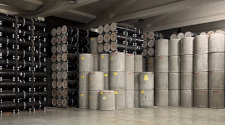
The Central Organisation for Radioactive Waste (COVRA) is the sole company in the Netherlands tasked with collecting, processing and storing all radioactive waste. It holds an annual meeting at which it presents the research and development (R&D) work it and its contractors are undertaking. Steve Benbow has recently attended the 2023 R&D meeting and presented the findings of the work that Quintessa has undertaken for COVRA to develop models to assess the possible bulk gas generation from its inventory of low and intermediate level waste (LILW), technologically enhanced naturally occurring radioactive materials ((TE)NORM) and high-level waste (HLW).
Gases (H2, CO2, CH4) can be generated in repositories for radioactive waste as waste packaging and waste materials corrode, degrade or decay. If gas accumulates, it could lead to a build-up of pressure that could potentially disturb the waste package, the repository or the host rock. Understanding the potential amount of gas that can be generated, and implementing engineering solutions to mitigate its consequences is therefore an important step when designing repositories for long-term disposal.
The potential amount of gas generation will be limited by the availability of source materials, such as metals in the waste packaging and metals and organics in the waste form, and the availability of reactants such as water. Water is present in some waste forms and will be expected to be present in repository conditions in both backfill materials and in the host formation. The availability of water to access the waste packages from the host rock will usually be a strong control.
COVRA commissioned Quintessa to develop models to assess the possible bulk gas generation from its inventory of LILW and HLW for its domal salt repository design. (See Figure 1.) The assessment included consideration of gas generation both in interim storage conditions and post-emplacement in the repository. Consideration of the interim storage period is important since any evolution during this period will affect the initial conditions for the post-emplacement period. Gas generating process implemented in the models included corrosion of metals, hydrolysis and degradation of organics and radiolysis of water/brine and organics. Corrosion rates in the models reflect varying porewater conditions, from oxic conditions in storage to anoxic conditions post-emplacement, and alkaline or neutral conditions depending on in-situ porewater chemistry and package design.


Figure 1: COVRA's HLW storage (top/left) and Interim LILW storage (bottom/right)
Simulations were run for each of COVRA’s 10 waste package types (4 HLW and 6 LILW). Different package types were found to be sensitive to availability of water to different extents. Most waste package types were found to be sensitive to the amount of water that was assumed to be added to the crushed salt backfill to aid workability of the material, since the resulting brine is key in the onset of corrosion of the outer waste packaging. Simulations were cross-verified by implementing the underlying conceptual model in Quintessa’s QPAC code and also in GoldSim. QPAC models were delivered to COVRA to enable further investigation of the effects of waste package/inventory assumptions and sensitivity to scenario and disposal concept variations. Example results are shown in Figure 2.




